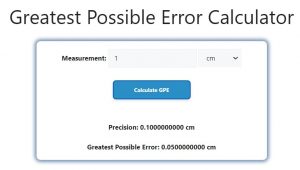About Greatest Possible Error Calculator (Formula)
The Greatest Possible Error (GPE) is essential in measurements and calculations where accuracy is crucial. It represents the maximum amount by which a measured value could deviate from the true value. This calculator simplifies the process of finding the greatest possible error, ensuring that you account for uncertainties in measurements and avoid costly mistakes.
Formula
The formula to calculate the greatest possible error is:
Greatest Possible Error (GPE) = Precision / 2
Where:
- Precision refers to the smallest unit or degree to which the measurement was made. For example, if the measurement is made to the nearest millimeter, the precision is 1 mm.
How to Use
- Determine the Precision: Identify the smallest unit of your measurement. This is often based on the measuring tool used.
- Apply the Formula: Divide the precision by 2 to find the greatest possible error.
- Use in Context: Apply this error margin to your measurements for improved accuracy and error estimation.
Example
Let’s say you measure a length to the nearest centimeter, meaning the precision is 1 cm. To find the greatest possible error:
GPE = 1 cm / 2
GPE = 0.5 cm
This means the greatest possible error in your measurement is 0.5 cm, so the true value could be up to 0.5 cm more or less than the measured value.

FAQs
- What is the greatest possible error?
The greatest possible error is half the precision of a measurement, representing the maximum potential deviation from the true value. - Why is calculating GPE important?
It helps ensure accuracy in measurements by accounting for the inherent uncertainty of the measuring tool or method used. - How do I determine the precision in measurements?
The precision is the smallest unit in which the measurement is recorded, such as millimeters, centimeters, or inches. - Can GPE be applied to all types of measurements?
Yes, GPE can be used for any measurement where precision is defined, including length, mass, volume, and time. - How does GPE relate to significant figures?
GPE provides a measure of uncertainty, while significant figures reflect the precision of the measurement itself. Both are used to express accuracy. - Can GPE be zero?
No, GPE cannot be zero unless the measurement is infinitely precise, which is impossible in real-world scenarios. - Is GPE the same for digital and analog measuring tools?
Yes, the concept of GPE applies to both types of tools, but the precision may differ depending on the accuracy of the device. - How do I apply GPE in real-world calculations?
Add or subtract the GPE from your measurement to account for the possible range of values. - Can GPE affect the final result of a calculation?
Yes, in cumulative measurements or calculations, small errors can add up, so GPE helps in estimating the overall error margin. - What is the difference between GPE and absolute error?
GPE is the maximum possible error based on the precision of the measurement, while absolute error is the actual difference between the measured and true value. - What happens if my precision is 0.01 units?
If the precision is 0.01, the GPE would be 0.005, meaning the error could be up to 0.005 units from the measured value. - How do I improve measurement precision and reduce GPE?
Use more accurate tools, take multiple measurements, and average the results to improve precision and minimize GPE. - What is the greatest possible error for a measurement of 0.5 cm precision?
The GPE for 0.5 cm precision is 0.25 cm. - Is GPE important in scientific experiments?
Absolutely. GPE is critical in experiments to quantify the uncertainty and reliability of the results. - How do I report measurements with GPE?
When reporting, add the GPE to your measured value, such as 10 cm ± 0.5 cm, indicating the possible range. - How does GPE relate to tolerance in manufacturing?
In manufacturing, tolerance refers to the allowable deviation, and GPE can help define the tolerance limits for products. - Can GPE be applied to time measurements?
Yes, GPE can be used in time measurements by dividing the precision of the time unit by two. - What is the GPE if the precision is 0.001 units?
The GPE would be 0.0005 units for that precision. - Can GPE be used in construction?
Yes, GPE is used in construction to ensure that measurements and material specifications stay within acceptable error margins. - What is the role of GPE in quality control?
GPE helps in defining acceptable error limits during quality checks to ensure products meet required specifications.
Conclusion
The Greatest Possible Error Calculator is a simple yet powerful tool that ensures accuracy and reliability in your measurements. By considering the possible margin of error, you can make better-informed decisions and maintain precision across various applications, whether in science, engineering, or everyday tasks. Understanding and calculating GPE helps prevent errors and improve the quality of your work.